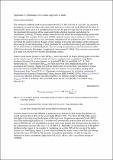Files in this item
Sound exposure in harbour seals during the installation of an offshore wind farm : predictions of auditory damage
Item metadata
| dc.contributor.author | Hastie, Gordon Drummond | |
| dc.contributor.author | Russell, Deborah Jill Fraser | |
| dc.contributor.author | McConnell, Bernie J | |
| dc.contributor.author | Moss, Simon | |
| dc.contributor.author | Thompson, David | |
| dc.contributor.author | Janik, Vincent M. | |
| dc.date.accessioned | 2016-05-19T23:32:23Z | |
| dc.date.available | 2016-05-19T23:32:23Z | |
| dc.date.issued | 2015-05-20 | |
| dc.identifier | 158288181 | |
| dc.identifier | 88ee26df-5416-4174-aaac-c4dadf7cb725 | |
| dc.identifier | 84929618374 | |
| dc.identifier | 000354811700011 | |
| dc.identifier.citation | Hastie , G D , Russell , D J F , McConnell , B J , Moss , S , Thompson , D & Janik , V M 2015 , ' Sound exposure in harbour seals during the installation of an offshore wind farm : predictions of auditory damage ' , Journal of Applied Ecology , vol. 52 , no. 3 , pp. 631-640 . https://doi.org/10.1111/1365-2664.12403 | en |
| dc.identifier.issn | 0021-8901 | |
| dc.identifier.other | ORCID: /0000-0002-1969-102X/work/49052038 | |
| dc.identifier.other | ORCID: /0000-0002-9773-2755/work/54819210 | |
| dc.identifier.other | ORCID: /0000-0001-7575-5270/work/56052225 | |
| dc.identifier.other | ORCID: /0000-0003-1546-2876/work/56862212 | |
| dc.identifier.other | ORCID: /0000-0001-7894-0121/work/60427867 | |
| dc.identifier.uri | https://hdl.handle.net/10023/8838 | |
| dc.description | The work was funded by the Department as part of its Strategic Environmental Assessment programme. In addition, support for D. Thompson was provided by the Natural Environment Research Council EBAO project. | en |
| dc.description.abstract | 1. With ambitious renewable energy targets, pile driving associated with offshore wind farm construction will become widespread in the marine environment. Many proposed wind farms overlap with the distribution of seals, and sound from pile driving has the potential to cause auditory damage. 2. We report on a behavioural study during the construction of a wind farm using data from GPS/GSM tags on 24 harbour seals Phoca vitulina L. Pile driving data and acoustic propagation models, together with seal movement and dive data, allowed the prediction of auditory damage in each seal. 3. Growth and recovery functions for auditory damage were combined to predict temporary auditory threshold shifts in each seal. Further, M-weighted cumulative sound exposure levels [cSELs(Mpw)] were calculated and compared to permanent auditory threshold shift exposure criteria for pinnipeds in water exposed to pulsed sounds. 4. The closest distance of each seal to pile driving varied from 47 to 405 km, and predicted maximum cSELs(Mpw) ranged from 170.7 to 195.3 dB re 1μPa2 -s for individual seals. Comparison to exposure criteria suggests that half of the seals exceeded estimated permanent auditory damage thresholds. 5. Prediction of auditory damage in marine mammals is a rapidly evolving field and has number of key uncertainties associated with it. These include how sound propagates in shallow water environments and the effects of pulsed sounds on seal hearing; as such, our predictions should be viewed in this context. 6. Policy implications. We predicted that half of the tagged seals received sound levels from pile driving that exceeded auditory damage thresholds for pinnipeds. These results have implications for offshore industry and will be important for policymakers developing guidance for pile driving. Developing engineering solutions to reduce sound levels at source or methods to deter animals from damage risk zones, or changing temporal patterns of piling could potentially reduce auditory damage risk. Future work should focus on validating these predictions by collecting auditory threshold information pre- and post-exposure to pile driving. Ultimately, information on population-level impacts of exposure to pile driving is required to ensure that offshore industry is developed in an environmentally sustainable manner. | |
| dc.format.extent | 903740 | |
| dc.format.extent | 802803 | |
| dc.language.iso | eng | |
| dc.relation.ispartof | Journal of Applied Ecology | en |
| dc.subject | Wind farms | en |
| dc.subject | Hearing | en |
| dc.subject | Marine animals | en |
| dc.subject | Pile driving | en |
| dc.subject | Pinnipeds | en |
| dc.subject | Renewable energy | en |
| dc.subject | Underwater noise | en |
| dc.subject | QH301 Biology | en |
| dc.subject | DAS | en |
| dc.subject | NERC | en |
| dc.subject | BDC | en |
| dc.subject | R2C | en |
| dc.subject | SDG 7 - Affordable and Clean Energy | en |
| dc.subject | SDG 14 - Life Below Water | en |
| dc.subject.lcc | QH301 | en |
| dc.title | Sound exposure in harbour seals during the installation of an offshore wind farm : predictions of auditory damage | en |
| dc.type | Journal article | en |
| dc.contributor.sponsor | NERC | en |
| dc.contributor.institution | University of St Andrews. School of Biology | en |
| dc.contributor.institution | University of St Andrews. Sea Mammal Research Unit | en |
| dc.contributor.institution | University of St Andrews. Marine Alliance for Science & Technology Scotland | en |
| dc.contributor.institution | University of St Andrews. Scottish Oceans Institute | en |
| dc.contributor.institution | University of St Andrews. Centre for Research into Ecological & Environmental Modelling | en |
| dc.contributor.institution | University of St Andrews. Institute of Behavioural and Neural Sciences | en |
| dc.contributor.institution | University of St Andrews. Centre for Social Learning & Cognitive Evolution | en |
| dc.contributor.institution | University of St Andrews. Bioacoustics group | en |
| dc.identifier.doi | 10.1111/1365-2664.12403 | |
| dc.description.status | Peer reviewed | en |
| dc.date.embargoedUntil | 2016-05-20 | |
| dc.identifier.grantnumber | NE/J004243/1 | en |
This item appears in the following Collection(s)
Items in the St Andrews Research Repository are protected by copyright, with all rights reserved, unless otherwise indicated.


